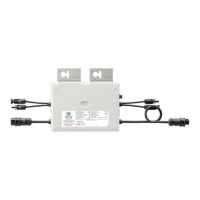7.1 LED Status Indications and Error Report
LED Startup:
The LED of each microinverter blinks red for a while at the beginning, and then
blinks green to indicate normal start-up approximately 10 seconds after DC
power is applied. If the LED blinks red after DC power is on, it indicates a failure
during the start-up.
Post-Startup LED Indications:
Check LED status to confirm the present situation.
Flashing Green: It indicates normal operation.
Flashing Red:
1. If red light flashes every 2 or 3 seconds, it indicates that the microinverter is
waiting for sun or prepare to produce energy.
2. If red light flashes continuously, it indicates that the microinverter is not
operating normally. The microinverter does not detect that the utility grid is
within operable voltage/frequency range. The microinverter cannot produce
power until this is solved.
7.2 Troubleshoot an Inoperable Microinverter
To troubleshoot an inoperable microinverter, follow the steps in the order shown
below.
WARNING: Be aware that only qualified personnel should troubleshoot the PV
array or the Envertech microinverter.
Best Practice: Please do not disconnect DC connection while the system is
working. Ensure that no current is flowing in the DC wires prior to disconnecting.
If necessary, use an opaque to cover the PV module prior to disconnecting the
PV module. Always disconnect AC power before disconnecting the PV module
from the Envertech microinverter. Disconnecting AC connectors of the
microinverters is also a means of cutting off AC power.
WARNING: The AC and DC connectors on the cabling are rated as a disconnecting
point only when used with an Envertech microinverter.
WARNING: Envertech microinverters are powered by DC power from the PV
modules. Please disconnect and reconnect DC power to check the LED blinks 1
minute after DC is applied.
1. Make sure AC breakers are on.
2. Check the connection to the utility grid and verify that the grid voltage is within
allowable ranges shown in the Technical Data section.
3. Verify that AC voltage at all solar power circuit breakers of the load centers
are within the ranges shown in the following table.
4. Verify that AC line voltage at the junction box for each AC branch circuit is
within the ranges required by local grid standards.
5. Confirm if the microinverter side is connected to the grid by measuring the
voltage from AC line to line and line to neutral.
6. Visually check if AC branch circuit connection is correctly done. Reinstall if
necessary.-Check also for damage, such as rodent damage.
7. Make sure that all circuit breakers are off.
8. Disconnect and re-connect the PV modules’ DC connectors with
microinverters. The LED status of each microinverter will blink green to indicate
normal start-up operation soon after DC power is applied (less than one minute).
9. Attach an ammeter clamp to one conducting wire of the DC cables from the
PV module to measure the microinverter’s current. This will be under 1 Amp if
AC is disconnected.
10. Check the DC connection between the microinverter and the PV module. The
connection may need to be tightened or reseated. If the connection is worn out
or damaged, it needs replacement.

